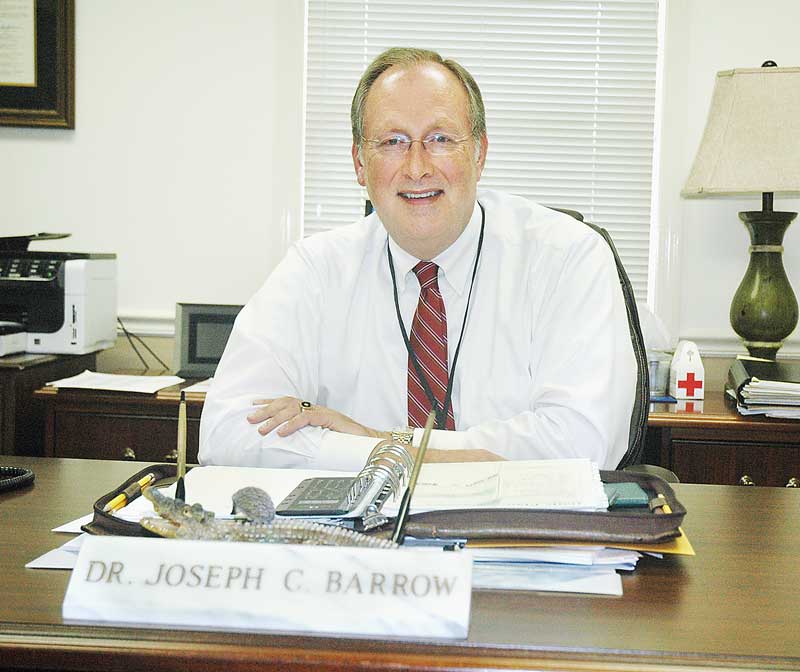[EDITOR’S NOTE: In response to questions raised in opinions about the 2019-2020 Fiscal Year budget for the Fayette County School System, Superintendent Dr. Joseph Barrow emailed this letter to The Citizen.]
The Fayette County Public School System is consistently recognized as one of the best school systems in Georgia and the nation. One example is the 2019 Best High Schools list published by U.S. News and World Report that lists all five of the county’s high schools as being in the top 24 percent of the best high schools in the nation.
This is quite an accomplishment for any community and any school district, but just being a very good school system does not answer every question that a community may ask.
Recently, a question was raised in an Op-Ed that was not about the quality of the school system, but rather the “exploding” budgetary concerns, specifically over the last few years from 2016 to 2020.
Conventional wisdom would note that in order to have a top quality school system, a community would need to invest in its local schools. Fayette County residents have consistently wanted top quality schools, and have consistently been willing to support the school district in paying property taxes, supporting bond initiatives, and most recently, E-SPLOST referendums.
If there has not been massive enrollment growth, the question begs for an answer for the budgetary increase.
This support continues to be critical in order to continue not only to maintain a high quality district, but also to push the district towards “world class” status. Merely increasing the system’s general fund budget is not the sole solution. But pushing the needle forward by offering top quality programing, recruiting and retaining the best quality educational staff, maintaining lower class sizes, keeping overall enrollment at schools at a reasonable number, providing excellent technology to students and teachers, and maintaining equity so that every child in Fayette County has access to a great education comes at a cost.
The duly elected Board of Education understands and listens to the citizens of Fayette County, and is pleased to share specific details in why the budget has increased. Citizens who were not able to attend the regular Board of Education meetings for the last six months can listen to podcast recordings of those meetings and witness firsthand the rationale used by the Board of Education. The budget development process is very transparent and open to the public.
The “why” premise of the budget increase question seems to be primarily rooted in the projected enrollment and modest student growth the district has experienced. If there has not been massive enrollment growth, the question begs for an answer for the budgetary increase.
It is important to note that there is not a one-to-one correlation between dollars spent and the number of students enrolled.
Student enrollment is one important variable, but it does not fully address the complexity of the budgeting process. It is important to note that there is not a one-to-one correlation between dollars spent and the number of students enrolled. There are textbooks and university courses that focus on educational finance, so our intent is not to try and respond to the depth of this complex issue, but to make salient points for the current budget, and to show that there are other variables than just student enrollment that must be factored into the budget process.
First, the state of Georgia has a constitutional responsibility to fund education in Georgia. In times past, the state has paid more than half (over 50 percent) of a county school system’s cost to educate the students who live in that county, and the local community makes up the difference.
Unfortunately, the state portion is now lower than 50 percent, and the local portion for Fayette County (the amount needed to maintain current programs and services) has had to provide a larger portion of the total. Fortunately, the state has increased the overall contribution over the last two years, restoring the austerity cuts that all Georgia systems have endured.
However, even with fully funding the Quality Basic Education (QBE) funding formula, it is based on 1985 dollars. (To fully review this would require another long explanation.) As an affluent county, Fayette pays the state five mills of tax annually, called the Local Fair Mill Share (LFMS – this amounts to approximately $28 million for the 2020 cycle), and the district receives no equalization funds in return.
Second, the business of education is a very labor intensive profession.
Second, the business of education is a very labor intensive profession. The school system is Fayette County’s largest employer with approximately 2,700 certified and classified employees. Most educational finance experts recommend that a district’s general fund employee cost fall between 85 and 90 percent of the total general budget. Our system’s FY20 budget is currently at 89 percent.
The majority of our staff is made of building level educators who work directly with children. However, as with any “big business,” there are necessary support staff (clerical, maintenance workers, bus drivers, custodial staff, food service workers). Staffing needs are highly scrutinized to insure the school system has the necessary staff needed to comply with federal and state minimums, but Fayette County has an expectation of “better than the minimum.”
Our system class size is below state requirements. Parents and teachers alike consistently expect low class sizes, and the district strives to maintain a balanced position with this community expectation.
The discussion that follows is focused on some of the factors increasing the budget since 2016. The first area of increase, and the factor that gets the most attention, is teacher pay. The Board has approved cost of living increases to help retain quality teachers and to be competitive with other schools systems. The most recent pay increases are as follows:
• 2017 – 3 percent cost of living for all staff; $4.1 million
• 2018 – 2 percent cost of living for all staff; $3.0 million
• 2019 – no increase
• 2020 – $3,000 flat increase on average teacher salary (an average salary is $63,000, so this is equal to a 4.8 percent increase); $6.3 million
• 2 percent COLA for non-certified staff; $550,000
• All years include a step or years of service increase
The school system has implemented cost of living increases each year that the state has included them in the state budget. When compared to other school systems, Fayette County is in a unique place in the metro Atlanta area. Fayette County cannot match the high salaries in counties to our north, but the school system is competitive with school systems in close proximity to the county.
One area of expense that the school district has no control over is the Teachers Retirement System employer contribution. This expense has nearly doubled since 2016.
The school system hires and retains experienced, highly qualified teachers, which is reflected in their certification level and years of experience, this places them at a higher pay level on the salary schedule. Fayette County teachers tend to have advanced degrees and more years in the profession when compared to other school districts.
One area of expense that the school district has no control over is the Teachers Retirement System employer contribution. This expense has nearly doubled since 2016. Of course, as salaries increase the retirement contribution will increase, but the contribution rate has accounted for more than half of the growth in total as the rate has grown 50 percent over this period of time.
• Teachers Retirement System rates and total contribution amounts:
• 2016 – 14.27 percent; $15.6 million
• 2017 – 14.27 percent; $17.0 million
• 2018 – 16.81 percent; $20.7 million
• 2019 – 20.90 percent; $25.9 million
• 2020 – 21.14 percent; $28.4 million
• Total increase from 2016 to 2020 is $12.8 million
Staffing has also increased, and the school district has made a concerted effort to add staff positions that will directly affect students in the classroom or support teachers in doing so.
Staffing has also increased, and the school district has made a concerted effort to add staff positions that will directly affect students in the classroom or support teachers in doing so.
One area that is always of concern is class size. Class size targets and requirements can vary based on grade level, subject matter, instruction delivery model, and size of school. For example, a larger school will make it easier to have larger, more consistent class sizes compared to a smaller school. Class sizes for kindergarten must be smaller than those at the high school level, and a physical education or music class can be managed with a large number of students compared to a normal mathematics course.
• Comparing staff allotment sheets for 2016 to 2020, the changes are as follows:
• Overall student teacher ratio
• 2016 – 16.9 to 1
• 2020 – 15.9 to 1
• Although not the same as class size, the student to teacher ratio reflects the school-based certified teaching staff directly involved with students. This number is smaller than class size because teachers have planning periods, and this ratio includes teachers for connections, art, music, chorus, etc.
• Decrease of one student on average per teacher over 20,000 equates to 50 additional teachers systemwide.
• Cost to reduce ratio by one student is $4.0 to $4.5 million.
• Increases in special education and speech language pathology.
• Special education teachers in the general fund increased by over 40 positions from 2016 to 2020.
• Includes seven elementary level lead teachers to better serve special education students in the classroom, and meet increased requirements of assessing and documenting special education services.
• Special education paraprofessionals increased by 38 from 2016 to 2020.
• Speech language pathologists increased by five.
• English to Speakers of other Languages (ESOL) services have also increased.
Other support areas have increased as well, with the goal of supporting teachers in classroom management and to improve student behavior and performance. Support staff in Response to Intervention (RtI) and Positive Behavioral Intervention Support (PBIS) programs have been strategically added to help provide teachers with the needed resources and support to create optimal learning environments for students.
A significant portion comes from the increase in technology as a delivery method of instruction.
Some operational factors have increased. A significant portion comes from the increase in technology as a delivery method of instruction. Although software costs have gone down since 2016, web-based subscription services have increased as the shift towards more electronic resources is being made.
The school system has gone from $1.6 million in software expenditures in 2016 to nearly $3 million in 2020 when including these web-based resources. This shift towards more use of technology has provided resources and opportunities for students to learn at any time and from any location.
Revenue Factors
One area that is affecting revenue is the percentage of property tax exemptions in the digest. As recent as 2008, the exemptions ran about 12 percent of the gross digest. In 2016, that rate was at 17.25 percent. For the 2019 digest, that ratio will be 18.3 percent. The impact of exemption increases negatively affects revenues, thus requiring a higher millage rate to bring in the same revenue amounts.
Another factor which negatively impacts revenue, and is based on the tax digest, is the previously mentioned local five mill share (LFMS). The state’s Quality Basic Education (QBE) earnings calculation is reduced by the equivalent revenue for the county digest at five mills. Even though our QBE earnings have increased, some of the increase is offset by the growth in the LFMS. In 2020, the LFMS reduction is $28 million compared to $22.3 million in 2016.
Financial Stewardship
Good financial management is the responsibility of the publicly elected Fayette County Board of Education. They closely review all revenue and expenditures. As part of the employment duties and responsibility of the system administration, the school district leaders are charged with being good stewards of taxpayers’ dollars and meeting the needs of the students and teachers.
Both the Board and the administration take these roles and responsibilities very seriously. The Fayette County community expects a high performing school district. The Fayette County community also expects good stewardship. The adopted FY20 budget is an investment to reach both of those expectations.
In conclusion, should any citizen have questions about topics not covered in this response, please contact the district’s Public Information Officer (PIO), Ms. Melinda Berry-Dreisbach, or the district’s Chief Financial Officer (CFO), Mr. Tom Gray, with specific questions, and we will work to provide requested information. As always, your support of the Fayette County Public School District is very much appreciated.
Joseph (Jody) C. Barrow, Jr., Ed.D.
Superintendent
Fayette County Public Schools
Fayetteville, Ga.










Leave a Comment
You must be logged in to post a comment.